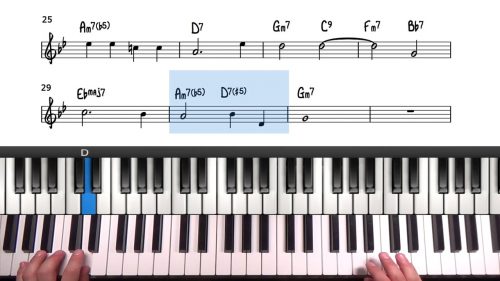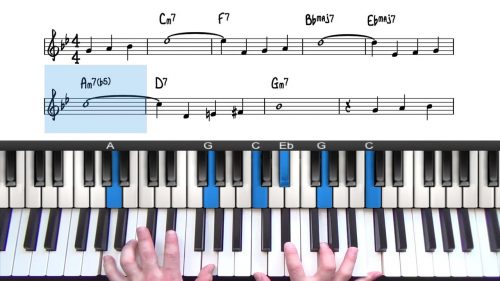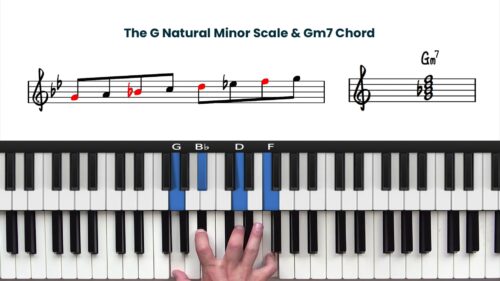Working With Singers: Goals & Expectations
Welcome to lesson 1 in this course on accompanying singers & vocalists. Moving from playing solo jazz piano to accompanying a singer can be a daunting task for many musicians.
The information covered in this lesson will give you an idea of what is expected of you as an accompanist and give you some tips and insight on working with singers to help them achieve their best performance.
We start by outlining the differences between the human voice and the piano and then move onto a number of important considerations that you should keep in mind whenever you are working with a vocalist.
The Voice Vs. The Piano
The voice as an instrument has a limited range in comparison to the piano’s massive 8 octaves. Some singers do boast a 5 octave range, but it’s much more common for singers to have between 2- 3 octaves.
Each voice is unique in its strengths and weaknesses. A good accompanist will feature the strengths and support the weaknesses through their playing. Even the most trained singer will need help with their pitch at times, this lesson covers some great ways to help a singer sound their best.
How To Accompany Jazz Vocalists
As the accompanying pianist, you want to follow the interpretation of the singer. A major component of that is the style. Autumn Leaves is a great example of a song that can be called in a different style. You will hear the tune played as a ballad, with a Latin feel and also medium swing.
Another component in the interpretation is the tempo. Many great jazz standards are super fun fast, but it’s impossible to sing certain lyrics at uber speeds as well as sounding silly.
You will also need to follow the singer’s dynamics and expression, building where they build, softening where they do. It also might mean going Rubato, or out of tempo. Often modes of expression are more tied to the lyrics, rather than following the standard form. So you must stay ready for any unexpected changes in tempo and feel.
Experienced singers can signal you through, using hand gestures, body language, eye contact or even vocal cues.
For less experienced singers, it’s a good idea to ask questions before you start if anything is unclear. This will help them understand the information you need to make their singing shine.
Practice Tips
-
Because of the nature of the human voice, no singer will be able to sing all songs in their original key. Some will fit perfectly, and for others it’s better to change the key to suit their range.
-
Even a 1/2 step or whole step can make a big difference and so being able to transpose is an important skill for an accompanying pianist. We explore this later in the course.
-
Most singers do not have perfect pitch, and often are singing one song to the next in different keys. Therefore, it's a good idea to give the melody line, or at least hints of the starting note in the introduction.
-
Some singers have more natural volume, others have quieter, sweeter voices. It’s up to the instruments to adjust their volume to the voice level.
-
If you are listening intently and can hear the singer clearly, then you’ll keep from overpowering their voice in both volume and complexity.





Wow, thank you Lyndol and Hayden. This is such a great intro video. I look forward to watching the rest very soon, and look forward to the information on transposition.
Thanks Natasha… really glad to hear you enjoyed the intro lesson. The first 4 lessons all use the tune “Autumn Leaves” for demonstration. We will then be using the tune “Summertime” for the transposition exercise. This is because the form is short (only 16 bars), the chords are relatively straightforward, and also repetitive which makes it an easy tune to get started with transposition 🙂
Cheers,
Hayden
Hello Hayden..Do you have a full guide of hand gestures?thks
Hi Ivan,
This currently doesn’t exist but I will speak with Lyndol and I’m sure she can put something together.
Another tip would be to watch singers live when playing in a jazz band.
See if you can pick up on the subtle cues that they give each other.
Leave the guide with me.
Cheers!
Hayden
I posted this yesterday but it’s not here today, so…
I read and know chords reasonably well but I’m stuck: I need to know which chords to put with the melody. Everyone seems to have a different answer, a way of learning, a pattern they used but I haven’t found the one that works for me. Any suggestions?
Hey Janet,
Good question!
Are you referring to playing solo piano here? Or when accompanying a vocalist? They are both very different in how you choose appropriate chord voicings.
This particular course outlines how to accompanying a singer – by first starting with the simplest of all voicings, and then gradually ‘layering in’ more complexity.
Lyndol recommends the following for students just starting out with accompaniment… When accompanying yourself, or a singer/vocalist, you should first stick to the ‘pillars of the chord’ which are the root, 3, 5, & 7.
If you are referring to solo piano performance, then how you create your voicings in relation to the melody is entirely different to when you are accompanying a singer.
Please specify which area you are referring to, and I will answer your question in detail 🙂
Cheers,
Hayden